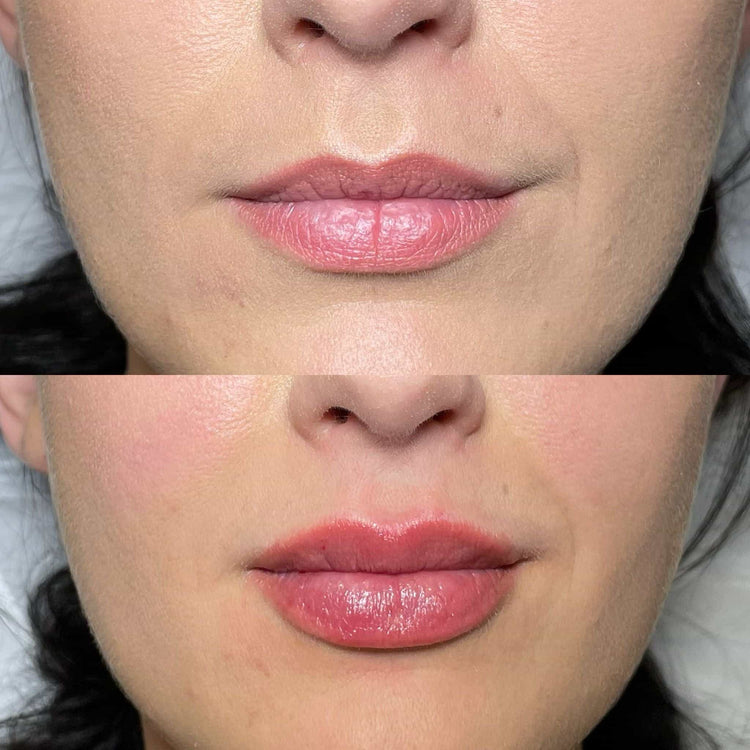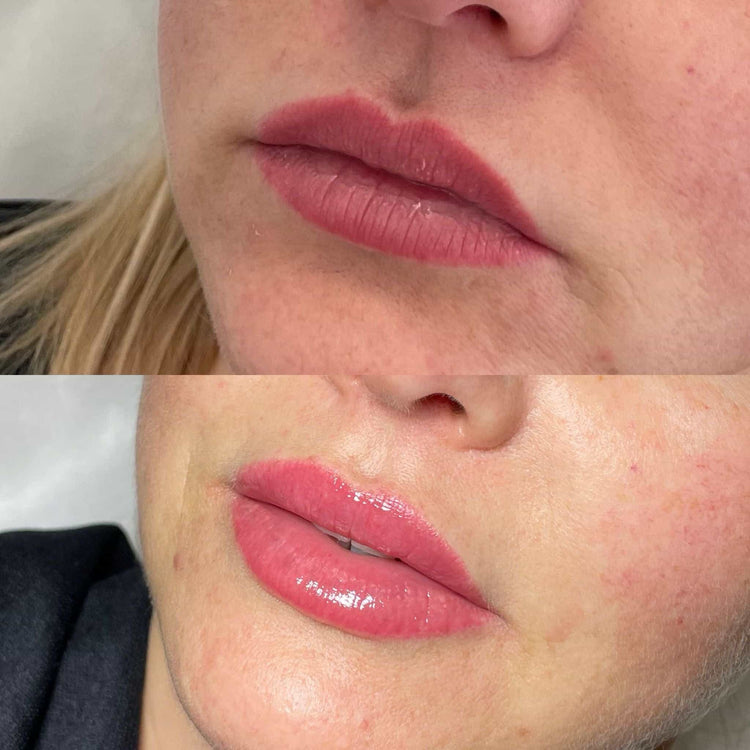Causes of Lip Filler Lumps
Lip fillers are a popular cosmetic procedure that can enhance lip shape and volume. However, some individuals may experience undesirable side effects, including lumps or bumps after treatment. Understanding the causes behind these irregularities is crucial for addressing them effectively.
Incorrect Injection Technique
Incorrect injection technique is a primary cause of lip filler lumps. When hyaluronic acid filler is not injected properly, it can clump together or create uneven deposits beneath the skin’s surface. This often occurs when the injector doesn’t use the right needle size or angle, or if they inject too much filler in one area. Overfilling also contributes to lumps, as the excess filler strains the surrounding tissues.
Overfilling the Lips

Another contributing factor is the type of hyaluronic acid filler used. Some fillers are more prone to clumping or creating irregularities than others. Additionally, individual patient factors such as skin thickness, elasticity, and blood flow can influence the appearance of lumps.
It’s important to choose a qualified and experienced injector who understands proper injection techniques and uses high-quality filler products.
Product Type and Quality
Lip fillers are a popular cosmetic procedure that can enhance lip shape and volume. However, some individuals may experience undesirable side effects, including lumps or bumps after treatment. Understanding the causes behind these irregularities is crucial for addressing them effectively.
Incorrect injection technique is a primary cause of lip filler lumps. When hyaluronic acid filler is not injected properly, it can clump together or create uneven deposits beneath the skin’s surface. This often occurs when the injector doesn’t use the right needle size or angle, or if they inject too much filler in one area. Overfilling also contributes to lumps, as the excess filler strains the surrounding tissues.
Another contributing factor is the type of hyaluronic acid filler used. Some fillers are more prone to clumping or creating irregularities than others. Additionally, individual patient factors such as skin thickness, elasticity, and blood flow can influence the appearance of lumps.
It’s important to choose a qualified and experienced injector who understands proper injection techniques and uses high-quality filler products.
Here are some additional tips for avoiding lip filler lumps:
- Research injectors thoroughly before booking an appointment. Look for board-certified plastic surgeons or dermatologists with experience in lip augmentation.
- Communicate your desired outcome clearly to the injector. Discuss any concerns you have about lumps or bumps.
- Follow the post-treatment instructions carefully to minimize swelling and bruising.
- Be aware that some mild swelling is normal after filler treatment, but it should subside within a few days.
Natural Healing Process
Lip filler lumps are generally caused by improper injection techniques or the use of certain types of hyaluronic acid fillers. When filler is not injected evenly or with the correct needle size and angle, it can clump together or create uneven deposits under the skin.
Overfilling the lips also contributes to lumps because excess filler stretches the surrounding tissues, potentially causing them to bunch up. The type of hyaluronic acid used can play a role as well; some formulations are more prone to clumping than others.
Fortunately, lip filler lumps often resolve naturally within a few weeks as the body begins to break down and reabsorb the filler. During this process, gentle massage around the affected area can help promote circulation and disperse any uneven deposits.
Applying cold compresses can also reduce swelling and discomfort. In some cases, your injector may recommend treatments like hyaluronidase, an enzyme that dissolves hyaluronic acid, to break down and remove stubborn lumps.
Remedies for Lip Filler Lumps
Lip filler lumps are a common concern for individuals who have undergone lip augmentation procedures. These irregularities can occur due to various factors, including improper injection techniques, the type of filler used, and individual patient characteristics. Understanding the causes behind lip filler lumps is crucial for finding effective solutions.
Massage Therapy
Lip filler lumps are generally caused by improper injection techniques or the use of certain types of hyaluronic acid fillers. When filler is not injected evenly or with the correct needle size and angle, it can clump together or create uneven deposits under the skin.
Overfilling the lips also contributes to lumps because excess filler stretches the surrounding tissues, potentially causing them to bunch up. The type of hyaluronic acid used can play a role as well; some formulations are more prone to clumping than others.
Fortunately, lip filler lumps often resolve naturally within a few weeks as the body begins to break down and reabsorb the filler. During this process, gentle massage around the affected area can help promote circulation and disperse any uneven deposits.
Applying cold compresses can also reduce swelling and discomfort. In some cases, your injector may recommend treatments like hyaluronidase, an enzyme that dissolves hyaluronic acid, to break down and remove stubborn lumps.
- Massage Therapy: Regular, gentle massage of the affected area can help disperse the filler and minimize the appearance of lumps.
Warm Compresses
Warm compresses are a simple yet effective remedy for lip filler lumps. Applying warmth to the area can increase blood flow and promote lymphatic drainage, helping to break down any clumps or uneven deposits.
To use a warm compress, soak a clean washcloth in warm water, wring it out gently, and apply it to the affected area for 10-15 minutes at a time. Repeat this several times a day for several days until the lumps subside.
Remember to avoid using excessive heat, as this can irritate the skin.
Hydration and Skincare
Lip filler lumps are generally caused by improper injection techniques or the use of certain types of hyaluronic acid fillers. When filler is not injected evenly or with the correct needle size and angle, it can clump together or create uneven deposits under the skin.
Overfilling the lips also contributes to lumps because excess filler stretches the surrounding tissues, potentially causing them to bunch up. The type of hyaluronic acid used can play a role as well; some formulations are more prone to clumping than others.
Fortunately, lip filler lumps often resolve naturally within a few weeks as the body begins to break down and reabsorb the filler. During this process, gentle massage around the affected area can help promote circulation and disperse any uneven deposits.
Applying cold compresses can also reduce swelling and discomfort. In some cases, your injector may recommend treatments like hyaluronidase, an enzyme that dissolves hyaluronic acid, to break down and remove stubborn lumps.
Lip hydration is essential for maintaining plump, youthful lips, and plays a role in the appearance of lip filler. Dry lips can make existing filler appear more lumpy or uneven.
Using hydrating lip balms and moisturizing regularly will help keep your lips supple and enhance the appearance of your filler.
Incorporating exfoliation into your skincare routine can also benefit lip filler longevity. Gently exfoliating the lips once or twice a week removes dead skin cells, promoting smoother application of any lip products and allowing filler to distribute more evenly
Dissolving Medication
Lip filler lumps are generally caused by improper injection techniques or the use of certain types of hyaluronic acid fillers. When filler is not injected evenly or with the correct needle size and angle, it can clump together or create uneven deposits under the skin. Overfilling the lips also contributes to lumps because excess filler stretches the surrounding tissues, potentially causing them to bunch up. The type of hyaluronic acid used can play a role as well; some formulations are more prone to clumping than others.
Fortunately, lip filler lumps often resolve naturally within a few weeks as the body begins to break down and reabsorb the filler. During this process, gentle massage around the affected area can help promote circulation and disperse any uneven deposits. Applying cold compresses can also reduce swelling and discomfort. In some cases, your injector may recommend treatments like hyaluronidase, an enzyme that dissolves hyaluronic acid, to break down and remove stubborn lumps.
Lip hydration is essential for maintaining plump, youthful lips, and plays a role in the appearance of lip filler. Dry lips can make existing filler appear more lumpy or uneven. Using hydrating lip balms and moisturizing regularly will help keep your lips supple and enhance the appearance of your filler.
Incorporating exfoliation into your skincare routine can also benefit lip filler longevity. Gently exfoliating the lips once or twice a week removes dead skin cells, promoting smoother application of any lip products and allowing filler to distribute more evenly.
Laser Treatment

Laser treatment can be an effective option for addressing lip filler lumps. Specifically, fractional laser therapy is often used.
This type of laser targets the affected area with tiny beams of energy, promoting collagen production and stimulating tissue remodeling. By improving skin texture and elasticity, fractional lasers can help smooth out irregularities caused by filler lumps.
The treatment typically involves multiple sessions spaced a few weeks apart to achieve optimal results.
Get the fuller lips you’ve always dreamed of with Dr. Laura Geige at It’s Me & You Clinic
- Why CBD Gummies Are A Great Option For Managing Symptoms Of Anxiety And Stress - November 10, 2025
- What Is The Best Filler For Sagging Cheeks? - November 9, 2025
- What Are The Benefits Of CBD Gummies For Weight Loss And Appetite Control - November 6, 2025
